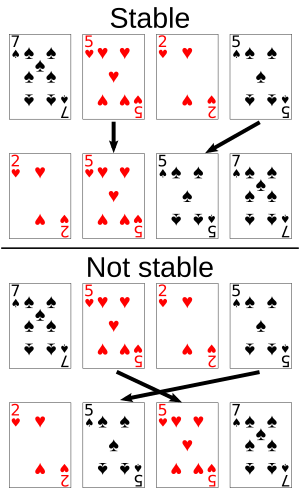Stable sorting algorithm facts for kids
A sorting algorithm is like a set of instructions that tells a computer how to arrange a list of items. These items could be numbers, words, or even playing cards. When we talk about a sorting algorithm being stable, it means something special happens if you have items that are exactly the same.
Imagine you have a list of students, and each student has a name and a score. If two students have the same score, a stable sorting algorithm will keep them in the same order they were in before you started sorting. For example, if Alex scored 80 and then Ben scored 80, a stable sort would always show Alex before Ben in the sorted list, as long as their scores are the same. If an algorithm doesn't guarantee this, it's called unstable.
What is Stable Sorting?
A sorting algorithm helps put things in order, like from smallest to largest or A to Z. When we sort items, we usually pick a "sorting key." This key is the part of the item we use to decide its order. For example, if you're sorting a list of people by age, their age is the sorting key.
A sorting algorithm is called stable if it keeps the original order of items that have the exact same sorting key. Think about our playing cards example. If you sort a deck by number, and you have two '7' cards (a 7 of Hearts and a 7 of Spades), a stable sort would make sure the 7 of Hearts stays before the 7 of Spades if it was originally placed that way.
Stable vs. Unstable Sorting
There are many different ways to sort things. Some sorting methods are naturally stable, and others are not.
- Merge sort is a good example of a stable sorting algorithm. It carefully combines sorted lists, making sure to keep the original order of equal items.
- Bubble sort is another stable sorting algorithm. It's quite simple to understand and implement, but it can be very slow for large lists.
- Quicksort is a very fast and popular sorting algorithm, but it is an example of an unstable one. This means if you have two items with the same value, Quicksort doesn't promise they will stay in their original order.
- Heapsort is another efficient sorting algorithm, but like Quicksort, it is also unstable.
Stability and Speed
It's important to know that whether an algorithm is stable or unstable has nothing to do with how fast or slow it is. The speed of a sorting algorithm is often described by its "complexity," which tells us how much work it needs to do as the list gets bigger.
For example, Bubble sort is stable, but it's one of the slowest sorting methods for large lists. On the other hand, Quicksort and Heapsort are very fast, but they are not stable. So, being stable doesn't mean an algorithm is better or worse in terms of speed; it just means it has a different rule for how it handles items that are the same.


